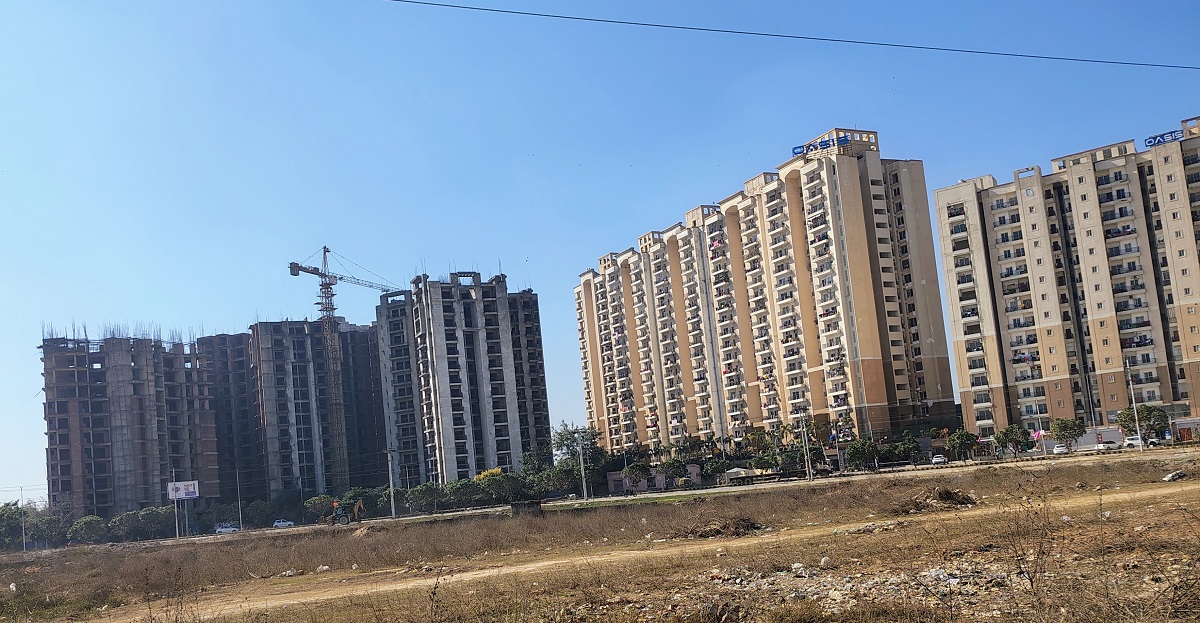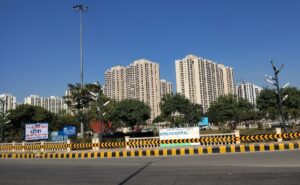
A lift gets stuck. People panic. This is not rare now. It is happening often in high-rise buildings across Greater Noida. Someone’s child, someone’s mother, or maybe just you—stuck mid-floor, waiting in silence.
In April 2024, at Fusion Homes, a little girl got trapped inside a lift alone. Fourth floor. Ten minutes inside felt like forever outside. Neighbours rushed in. No alarm worked. The video spread fast. People watched. Some forgot. Others began to ask, why so many failures?
Two weeks later, Gaur City 2, 14th Avenue. Lift stuck again. This time eight people. Four were school kids. Power went out. Lift did not auto-open. Emergency light was dead. Residents forced the door open after waiting half an hour. That was the third breakdown in ten days.
Greater Noida has over 300 societies with multi-storey towers. More families are moving in each month. But how many know if their lifts are truly safe? Do you know if yours is even registered under the UP Lift Act 2024? Or when it was last serviced?
This article breaks it down. Who checks your lift. What the law says. What signs to look for. And most importantly, how you can check if your own building is safe.
Why Lift Safety Feels Risky in Greater Noida Apartments Today
Lifts break down. That is not new. But in Greater Noida, it is happening more often—and it feels worse. People step in and do not know if they will reach their floor or get stuck in between.
Since 2023, more high-rises have come up fast in places like Sector 16C, Techzone IV, and Noida Extension. Thousands of families moved in. But the pace of lift maintenance has not kept up. Societies that look modern outside often hide old service logs, skipped inspections, or non-working alarms inside.
Many complaints are now seen in Gaur City, Exotica Dreamville, and Supertech Ecovillage. Parents post on Twitter. Some share CCTV clips. In one video, the lift door shakes hard before opening. No emergency light. No technician came for 40 minutes.
These stories are not just rumours. They show a deeper problem. Rapid apartment growth without clear maintenance planning. RWAs often change vendors every year to save money. That breaks service cycles.
The UP Lift Act 2024 now makes lift registration and inspection logs compulsory. But few residents even know this. In some buildings, the lift still runs unregistered.
Who Should Fix the Lift? RWA, Vendors or Authority?
When a lift gets stuck, nobody really knows who to blame first. People call the guard. The guard calls someone else. But the lift? Still stuck.
The truth is, it starts with your RWA or AOA. They are the ones who pick the vendor. They are supposed to track complaints, review service reports, and make sure maintenance is not skipped. But do they? Sometimes yes. Often no.
Most vendors come in with a promise—fast service, monthly checks, working alarms. Some even do it well. But if the RWA does not follow up, or worse, switches vendors every year just to save some money, then what? The service cycle breaks. Gaps open. Small issues grow.
“The lift does not fail in one day. It fails slowly—because people stop checking.”
And here comes the law. The UP Lift Act 2024 makes one thing clear. Every lift must be registered. Inspected. Certified. If the lift runs without this, your society can be fined. This already happened in Ghaziabad. Expired license. Penalty paid.
Why Do Lifts Break Down? The Hidden Reasons
We have seen that lifts in Greater Noida sometimes break down. But why does this happen? It is a very important question, right? There are clear reasons why lifts stop working or become unsafe. Let’s look at each reason in detail.
Lifts Not Looked After Properly
Many lift problems start with how they are cared for. Lifts are like big, complex machines. They need constant, good care, just like a car needs regular service.
Not Checked Enough
Often, lift maintenance issues begin because lifts are simply not checked often enough. They should be looked at by experts very regularly. When these important checks are missed, small problems inside the lift do not get found early. They slowly grow bigger and bigger. Then, without warning, the lift breaks down.
Repair Work is Not Good
Even when checks are done, the repair work itself might not be good. Sometimes, the people from lift maintenance companies fix things quickly but not properly. They might replace one part but miss another, or use a cheap part. This leaves hidden dangers inside the lift. The problem often comes back soon, or a new one starts because of bad repair work.
Old Lifts Get Problems
Just like old people get tired, old lifts also get tired. The age of a lift is a very big reason why it might cause trouble.
Parts Wear Out
Old lifts problems are very common. After many years of working hard, the parts inside the lift simply wear out. They get old and tired. They might start making strange noises or move slowly. These old, worn-out parts can break down suddenly, causing the lift to stop or act dangerously.
Missing New Safety Gear
Older lifts might not have the newest safety features that modern lifts use. They need lift modernization. For example, newer lifts have special systems to prevent falls or to automatically open doors when stuck. Without this new safety gear, older lifts are not as safe. Modern technology makes lifts much, much safer for everyone who uses them.
Other Big Reasons for Lift Problems
Besides age and care, a few other important things can cause lifts to fail.
Too Many People Inside
Every lift has a limit on how many people or how much weight it can safely carry. You can see this limit written inside the lift. If too many people go inside, it is called overloading the lift. This puts a huge amount of stress on the lift’s parts. It can make the lift stop suddenly. It can also damage the lift over time, making it unsafe. Always check the limit.
Bad Work From the Start
Some lift problems begin a very long time ago, right when the building was new. If the lift installation quality was poor from the very beginning, problems will show up later. The company that put the lift in might have used weak parts. Or they might have connected the wires badly. This creates hidden dangers that are very hard to find until the lift causes trouble.
Electric Power Jumps
Lifts need a very steady supply of electric power to work correctly. When the power goes up and down suddenly, it can confuse the lift’s computer system. Also, if a building does not have strong backup power when the lights go off, the lift can get stuck. This sudden change in power affects lift safety very much.
How Lift Problems Affect Your Daily Life?
Lifts breaking down is not just a news story. It affects real people. Right here. In Greater Noida. These are not small problems. They change how your day begins, moves, and ends. Let us see how deeply it touches daily life.
Late For Work and School
You are ready. But the lift is not. It gets stuck. Or takes forever to come. You are now late. Office time lost. Class missed. Just standing there. Waiting. And worrying. What should take seconds ruins your whole morning.
Everyday Tasks Become Tiring
Carrying groceries. Taking down garbage. Helping a child walk. These things feel simple. But without a lift, they become heavy. So many stairs. Floor after floor. Up and down. Again and again. It drains your energy. Your time. Your peace.
Fear of Getting Stuck
Every ride feels risky. You press the button. Step in. And in the back of your mind—what if it stops? Inside that small box, lights flicker, air gets still. Your heart beats fast. This fear does not go away. It comes with you. Every single time.
Too Hard for Some People
Now think of others. Your elderly parents. A child who cannot walk far. A person in a wheelchair. Or a woman in her last month of pregnancy. A broken lift means they are stuck. Not just in a moment. Sometimes all day. They cannot move. They miss life.
Trust Starts to Break
When lifts keep failing, you stop trusting. First the machine. Then the builder. Then the RWA. You ask, who is fixing this? Do they care? Your home should feel safe. But now, even going down feels like a risk.
How to Stay Safe When Using Lifts
Lifts break down. We all know that. But you are not helpless. Not at all. You can do simple things to stay safe. To protect yourself. Your family. Your neighbors. These steps help keep you and your family safe when using lifts.
1. Check the Lift Sticker
Every safe lift has a sticker. It is usually stuck inside, near the buttons. Not fancy. Just a sticker. But it means something big.
That sticker says the lift is registered. That someone came. Checked it. Approved it. The UP Lift Act 2024 says this is the rule now. No sticker? Do not enter. It takes two seconds to check. But those two seconds matter.
2. Do Not Overload the Lift
Every lift has a limit. The board says five people. Or 400 kg. Not six. Not seven. Not even one more.
Why? Because lifts fail under pressure. Real pressure. Extra weight strains the system. Wires. Brakes. All of it. That’s how they stop. Or worse. Check the sign. Count the people. If it feels full, skip the ride. Wait. It is worth it.
3. Use the Emergency Button
If a lift stops or gets stuck, do not panic. Look for the buttons with a bell or a phone sign. These are your emergency buttons. It is right near the panel. That is your emergency button. Press it. Hard. It rings a loud sound. Or connects to someone.
Do not wait to panic. Find the button the moment you enter. Know where it is. Just in case.
4. Stay Calm, Wait for Help
The doors are shut. But you are not alone. Never try to force them open by yourself. That is very risky. Just breathe. Stay still. Call through the button. Your building staff will come. The RWA knows the drill. They have a plan. You are not alone.
5. Know Your Building’s Rescue Plan
It is a good idea to ask your RWA (Resident Welfare Association) about the building’s lift emergency plan. Find out what numbers to call if a lift gets stuck. Ask who comes to help. Knowing your building’s specific rules and contacts makes a big difference if you ever face a lift problem.
6. Use Stairs for Short Trips
If you are going up or down just one or two floors, consider using the stairs. It is good for your health, you know. And it means one less ride on a lift that might have hidden problems. It is a simple, smart choice for daily movement.
7. Watch Children Around Lifts
Children are naturally curious and might not know the dangers. Always keep a close eye on children when they are near lifts. Make sure they do not play with the buttons or try to open the doors. Teach them important lift safety tips early.
8. Report Problems Immediately
If you hear a strange noise in the lift, or it shakes a bit, tell your RWA right away. Even small problems can become big, dangerous ones if no one reports them. Your quick report helps ensure that everyone stays safe. This is a very key reporting lift issues step for the whole community.
Who Is Responsible for Lift Safety in Your Building?
Lift safety in your building starts with real people who live and work there, not just outside technicians. The ones truly responsible are property owners, RWAs, AOAs, and lift contractors—each holding a defined legal and daily role in keeping lifts safe and usable for all.
Inside Your Building, It Starts With Your Own RWA or AOA
The Resident Welfare Association (RWA) or Apartment Owners Association (AOA) in your building has the first line of responsibility. These groups are not just helpers—they are the decision-makers who manage everything from water tanks to lift contracts.
They collect maintenance funds, often through monthly fees. A big chunk of this money goes directly to the lift care budget. That means they choose the lift maintenance agency, sign contracts, and track service schedules. If your lift keeps stopping midway or makes strange sounds, it is the RWA or AOA’s job to respond fast and get it repaired.
The Law Makes Registration Mandatory (UP Lift Act 2024)
Under the UP Lift Act 2024, every lift in Uttar Pradesh must be registered with the state authorities. This rule is not optional. If the lift is running without registration, it is illegal and unsafe.
The responsibility to register the lift does not fall on individual flat owners. It falls on the RWA or AOA. They must submit lift specifications, ensure proper inspection reports are updated, and renew safety certificates every year. Without this, no AMC (Annual Maintenance Contract) is legally valid.
Who Else Shares Responsibility?
Once the RWA or AOA hires a licensed lift company, that vendor must provide:
- 24/7 service support
- Quarterly inspection logs
- Breakdown response under 2 hours
- Insurance for lift parts and public liability
All this must be recorded, signed, and made available during surprise audits.
Still, the RWA is not off the hook. They are accountable if the vendor fails to act. That is why vendor performance review every 6 months is critical.
What Should You Do as a Resident?
You can check:
- The sticker inside the lift showing registration date and vendor name.
- The noticeboard or app showing lift servicing dates.
- Whether the RWA shares PDF reports or monthly activity logs.
- If insurance and AMC papers are accessible on request.
Even if you are not part of the managing body, you can still ask questions, demand updates, or attend general body meetings.

 Local Lifestyle
Local Lifestyle

